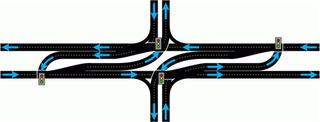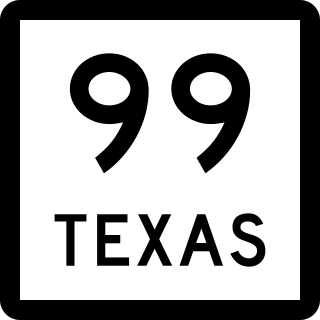
San Antonio, officially the City of San Antonio, is a city in and the county seat of Bexar County, Texas, United States. The city is the seventh-most populous in the United States, the second-largest in the Southern United States, and the second-most populous in Texas after Houston. San Antonio is the largest city of the San Antonio–New Braunfels metropolitan statistical area. Commonly called Greater San Antonio, the metropolitan area had a population of 2,601,788 based on the 2020 U.S. census estimates, making it the 24th-largest metropolitan area in the United States and third-largest in Texas.

Interstate 37 (I-37) is a 143-mile (230 km) Interstate Highway located within the southern portion of the US state of Texas. The highway was first designated in 1959 as a route between Corpus Christi and San Antonio. Construction in the urban areas of Corpus Christi and San Antonio began in the 1960s, and the segments of the Interstate Highway in rural areas were completed by the 1980s. Prior to I-37, the route between Corpus Christi and San Antonio was served by a combination of State Highway 9 (SH 9) from Corpus Christi to Three Rivers and US Highway 281 (US 281) from Three Rivers to San Antonio. As a result of the construction of I-37, SH 9 was removed from the State Highway System.

U.S. Route 281 (US 281) is a north–south United States Numbered Highway. At 1,875 miles (3,018 km) it is the longest continuous three-digit U.S. Route.

U.S. Route 290 is an east–west U.S. Highway located entirely within the state of Texas. Its western terminus is at Interstate 10 southeast of Segovia, and its eastern terminus is at Interstate 610 in northwest Houston. It is the main highway between Houston and Austin and is a cutoff for travelers wanting to bypass San Antonio on Interstate 10. Throughout its length west of Austin, US 290 cuts across mountainous hills comprising the Texas Hill Country and the Edwards Plateau; between Austin and Houston, the highway then travels through gradually hilly grasslands and pine forests comprising the Gulf Coastal Plains.

A superstreet, also known as a restricted crossing U-turn (RCUT), J-turn, or reduced conflict intersection (RCI), is a type of road intersection that is a variation of the Michigan left. In this configuration, in contrast to the Michigan left, traffic on the minor road is not permitted to proceed straight across the major road or highway. Drivers on the minor road wishing to turn left or go straight must turn right onto the major road, then, a short distance away, queue (wait) into a designated U-turn lane in the median. When traffic clears, they complete the U-turn and then either go straight or make a right turn when they intersect the other half of the minor road.

Interstate 410 (I-410), colloquially Loop 410, is an auxiliary route of I-10 around San Antonio, Texas. It is identified as the Connally Loop in honor of former Texas Governor John Connally.

State Highway 99, also known as the Grand Parkway, is a beltway in the U.S. state of Texas. Its first section opened on August 31, 1994. When the route is completed, it will be the longest beltway in the U.S., the world's seventh-longest ring road, and the third (outer) loop of the Houston–The Woodlands–Sugar Land metropolitan area, with Interstate 610 being the first (inner) loop and Beltway 8 being the second (middle) loop. The proposed 170-mile (270 km) loop has been divided into 11 separate segments for construction and funding purposes. In May 2019, the Texas Department of Transportation gave the Grand Parkway a secondary designation as the Mayor Bob Lanier Memorial Parkway, honoring Bob Lanier, who served as the mayor of Houston from 1992 to 1998 and who had spearheaded the creation of the Grand Parkway.
The Harris County Toll Road Authority maintains and operates a 103-mile (165.8 km) toll road system in the Greater Houston area of Texas, United States. Its headquarters are located in Houston's Fairbanks/Northwest Crossing neighborhood.

Loop 1604 is the outer highway loop encircling San Antonio, Texas, spanning approximately 95.6 miles (153.9 km). Originally constructed as a two-lane highway, the northern segment of the route, from US 90 in western San Antonio to Kitty Hawk Road in northeastern Bexar County, has been upgraded to a four-lane freeway. Loop 1604 is designated the Charles W. Anderson Loop in honor of former Bexar County Judge Charles W. Anderson, who died from cancer in 1964 after serving for 25 years.

State Highway 130 (SH 130), also known as the Pickle Parkway, is a freeway from Interstate 35 (I-35) in San Antonio along I-410 and I-10 to east of Seguin, then north as a toll road from there to I-35 north of Georgetown. SH 130 runs in a 91-mile (146 km) corridor east and south of Austin. The route parallels I-35 and is intended to relieve the Interstate's traffic volume through the San Antonio–Austin corridor by serving as an alternate route.

State Highway 151, also known as the Raymond E. Stotzer Jr. Freeway, is a 10.7-mile (17.2 km) state highway in the U.S. state of Texas that runs from Loop 1604 to U.S. Highway 90 (US 90) in San Antonio. SH 151 is a limited-access freeway for its entire length with the exception of its junction with Loop 1604 at its western terminus where a traffic light controls the junction. The routing of the freeway was first conceived in 1983 and construction was conducted in phases through the 1980s and 1990s until completion in 2004. The freeway provides access to the western part of San Antonio, the SeaWorld San Antonio theme park, Chase, Northwest Vista College, and the future site of a Microsoft data center.

Interstate 10 (I-10) is the major east–west Interstate Highway in the Southern United States. In the U.S. state of Texas, it runs east from Anthony, at the border with New Mexico, through El Paso, San Antonio, and Houston to the border with Louisiana in Orange. At just under 880 mi (1,420 km), the Texas segment of I-10, maintained by the Texas Department of Transportation, is the longest continuous untolled freeway in North America that is operated by a single authority. It is also the longest stretch of Interstate Highway with a single designation within a single state. Mile marker 880 and its corresponding exit number in Orange, Texas, are the highest numbered mile marker and exit on any freeway in North America. After widening was completed in 2008, a portion of the highway west of Houston is now also believed to be the widest in the world, at 26 lanes when including feeders.

U.S. Route 90 is a major east-west highway in the U.S. state of Texas with large portions of it running concurrently with I-10. US 90 begins at Bus. I-10 in Van Horn, travels through San Antonio and Houston, and continues on into the state of Louisiana.

U.S. Route 281 (US 281) is a United States Numbered Highway that runs from the Mexican border in the Rio Grande Valley to the Canadian border near Dunseith, North Dakota. In the state of Texas, the highway is a major south–north corridor, connecting Brownsville to the Oklahoma state line at the Red River in Burkburnett. Several segments of U.S. 281 are concurrent with Interstate routes, including I-69C in the Rio Grande Valley, I-37 in San Antonio, and I-44 north of Wichita Falls.

Interstate 35 (I-35) is a major north–south Interstate Highway that runs from Laredo, Texas near the Mexican border to Duluth, Minnesota. In Texas, the highway begins in Laredo and runs north to the Red River north of Gainesville, where it crosses into Oklahoma. Along its route, it passes through the cities of San Antonio, Austin, and Waco before splitting into two branch routes just north of Hillsboro: I-35E heads northeast through Dallas, while I-35W turns northwest to run through Fort Worth. The two branches rejoin in Denton to again form I-35, which continues to the Oklahoma state line. The exit numbers for I-35E maintain the sequence of exit numbers from the southern segment of I-35, and the northern segment of I-35 follows on from the sequence of exit numbers from I-35E. I-35W maintains its own sequence of exit numbers.

Spur 345 is a 5.1-mile-long (8.2 km) route in Greater San Antonio in the U.S. state of Texas, maintained by the Texas Department of Transportation (TxDOT). It follows a former route of U.S. Route 87 (US 87) through Balcones Heights and northwest San Antonio. Known locally as Fredericksburg Road, it is a major arterial for the cities of San Antonio and Balcones Heights, providing access to the headquarters of United Services Automobile Association (USAA) and to the South Texas Medical Center.

Loop 368 is a state highway loop in the U.S. state of Texas that follows a former route of US 81 in San Antonio. 8.115 miles (13.060 km) in length, the route is a major arterial in the city, providing access to Brackenridge Park, the San Antonio Zoo, and the University of the Incarnate Word.
The North Tarrant Express (NTE) project is a total highway reconstruction of the Interstate 820 (I-820) and State Highway 121/State Highway 183 corridor between I-35W and Industrial Boulevard in Northeast Tarrant County, Texas. The NTE and the Texas Department of Transportation (TxDOT) anticipate the new highway system will relieve traffic congestion, improve safety on its roadways and have integrated plans for the anticipated traffic growth in one of the country’s fastest developing regions. When the improvements are completed, the $2.5 billion North Tarrant Express will have upgraded main highway lanes, continuous frontage roads, and 13.3 miles (21.4 km) of newly added tolled managed lanes.

Farm to Market Road 2696 is a 16-mile (26 km) farm to market road in Bexar County, Texas. It is known in Greater San Antonio as Blanco Road, a major north–south thoroughfare.

State Highway Spur 536 is a state highway spur in San Antonio, Texas.


















